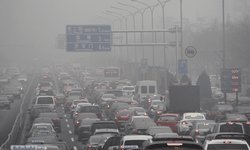China Auto Industry Unfair 'Scapegoat' for Toxic Smog, Trade Group Says

"The auto industry has already borne too much undeserved responsibility in recent years with the purchase and usage restrictions," said Ye Shengji, deputy secretary general of the China Association of Automobile Manufacturers. "With the toxic smog, the auto industry is once again being blamed and scapegoated as the main culprit, which is unreasonable."
The comments signal increasing concern among automakers that the central government may impose further measures to restrict the growth of the vehicle population, which reached 240 million last year.
China added more cars last year than the total number plying its roads in 1999, according to data from the public security ministry.
"The automobile industry is a part of the problem, although how much they are to blame is hard to determine," said Ole Hui, an auto analyst at Mizuho Financial Group Inc. in Hong Kong "With increased fleet size on the road, there is increased pollution and this problem is going to get bigger."
China's State Council issued a timetable on Feb. 6 for stricter car fuel emissions standards to be adopted nationwide by the end of 2017, and required domestic oil refiners to upgrade their equipment to provide cleaner fuel to match the strictest European Union standards.
Since Feb. 1, Beijing has required new cars to meet the higher standards, becoming one of the first cities in China to do so.
Vehicle exhaust
While vehicular exhaust is undeniably one of the main sources of air pollution, to blame the recent toxic smog solely on car emissions "lacks scientific proof," Ye said, according to a transcript of his comments in a group interview with local media that was posted on the state-backed association's website.
Tailpipe emissions accounted for 22 percent of the PM2.5, fine airborne particulates that pose the largest health risks, Ye said, citing Beijing municipal government data. This means the majority of the pollution can't be blamed on vehicles, he said.
Other major sources of pollution include coal-generated power plants and factory emissions, surface dust and construction sites, Ye said.
The short supply of fuel that meet statutory standards on emission and lack of regulatory enforcement also contributed to the pollution, he said.
Official measurements of PM2.5 in Beijing rose as high as 993 micrograms per cubic meter on Jan. 12, compared with WHO guidelines of no more than 25.
The daily average for January was 196 micrograms per cubic meter, compared with an average of 166.6 measured last year in 16 U.S. airport smoking lounges by the Centers for Disease Control and Prevention in Atlanta.
Nouvelles connexes


